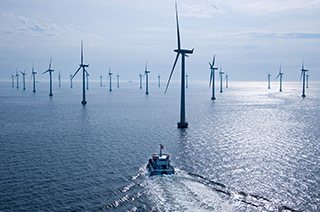Offshore wind energy developers RES Americas Developments Inc. and US Wind Inc. will pay a combined $1.08 million for leases to build turbines across nearly 344,000 acres in the ocean off New Jersey Monday, as the federal Bureau of Ocean Energy Management opened an area for development from east of Long Beach Island south to Cape May.
US Wind won the competitive auction for the northern 160,000 acres, and RES America got the southern 184,000-acre section, according to BOEM officials. A third bidder, New Jersey natives Fishermen’s Energy, who are trying to build a five-turbine demonstration project in state waters, did not get an offshore lease.
 BOEM proposed lease area off New Jersey.US Wind already has federal leases off Maryland, and has been talking to Gulf Island Fabrication Inc. about its potential future needs for turbine foundations in those areas. RES America was also a successful bidder on an earlier BOEM sale off Massachusetts, said Jim Bennett, BOEM’s director of renewable energy.
BOEM proposed lease area off New Jersey.US Wind already has federal leases off Maryland, and has been talking to Gulf Island Fabrication Inc. about its potential future needs for turbine foundations in those areas. RES America was also a successful bidder on an earlier BOEM sale off Massachusetts, said Jim Bennett, BOEM’s director of renewable energy.
“Both companies are established and we have had good experiences working with them,” said BOEM deputy director Walter Cruickshank. The prices paid for the New Jersey leases worked out to $5.49 per acre, about middle of the road for wind lease auctions, Cruickshank and Bennett said.
“With provisional winners for both lease areas, we are optimistic about the promise of a strong renewable energy future offshore New Jersey, as well as for the entire nation,” BOEM Director Abigail Ross Hopper said, after seven rounds of bidding Monday. “I look forward to working with the members of the New Jersey Renewable Energy Task Force and the public on future wind energy projects proposed for these leases by RES America Developments Inc. and US Wind Inc.”
Renewable energy advocates have criticized New Jersey Gov. Chris Christie’s administration for not moving faster on rules to help offshore wind development, although state utility regulators have promised to make a renewed push. But Cruickshank said BOEM did not see that as a barrier to holding the auction, because other Atlantic states near existing leases are still completing their own systems to incorporate offshore wind power.
In the meantime, BOEM officials said they will continue working with stakeholder groups who have concerns about spatial and traffic conflicts in the near shore ocean. The agency held informal meetings with mariners in New Jersey and New York last week.
“The traffic separation schemes are one thing we’re still working through…and the (location of) cables to shore to transmit the electrical power,” Bennett said.
It will take time before turbines get built; the developers have nearly five years to submit construction and operation plans to BOEM, which will then conduct reviews under the National Environmental Policy Act.
Abundant natural gas at cheap prices took the urgency out of developing offshore wind energy, which was a priority in the first term of the Obama administration – and in 2010, when the state Legislature and Christie administration set a goal of developing 1,100 megawatts of offshore wind in the coming years.
But the Fishermen’s Energy project backers have been at loggerheads for years with New Jersey regulators, who insisted the $220 million project would be a bad deal for ratepayers, even with a $47 million commitment from the U.S. Department of Energy. After failing a final bid for appeal in the state courts, Fishermen’s Energy is redesigning its project with Siemens turbines proven in the European industry.
The consortium – named for New Jersey fishing and seafood businesses who are investors – is apparently prepared to wait out the Christie administration’s final year. “That’s in the next governor’s term,” said chief operating officer and counsel Paul J. Gallagher Sr.
In Massachusetts, the ambitious Cape Wind project took a major blow last winter when potential power purchasers backed out of their contracts. But in July, the start of another small pilot project in Rhode Island gave the nascent industry a boost.
Deepwater Wind set the first foundations for a five-turbine, 30-megawatt project off Block Island, a community that depends on diesel generators for most of its power. Rhode Island’s Democratic political leadership have bet heavily on the Deepwater project, which would power Block Island, feed into the state’s southern mainland grid -- and may be be the start of a new industry.
The Deepwater Wind project is closely watched by companies that serve the offshore energy sector. Gulf Island Fabrication Inc., which builds production platforms for the Gulf of Mexico offshore oil industry, made foundations for the five Block Island turbines at its facility in Houma, La., with final assembly done by a Rhode Island subcontractor at Quonset Point. Company officials see more business potential in East Coast wind.
In an Oct. 30 conference call with analysts on Gulf Island Fabrication’s third quarter earnings, CEO Kirk J. Meche highlighted his company’s contribution to the Rhode Island project – and the national news media attention it brought.
Meche said he’s been talking to Fishermen’s Energy, and has hopes for that venture despite its problems with New Jersey regulators. Meanwhile, Gulf Island Fabricators has been in talks with backers of a Maryland project in federal waters that could be 125 to 150 turbines, Meche said.
“So that market it appears to be going very well,” Meche said. “That’s getting a lot of traction on the good publicity for us, so our name is pretty well known along the East Coast in terms of offshore wind fabrication.”




